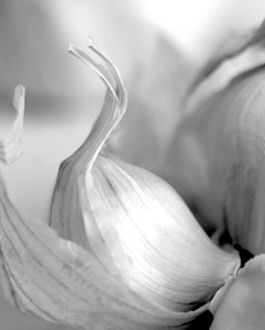home | metro santa cruz index | santa cruz county restaurants | review

Photograph by Ari LeVaux
Head Strong: The growing of homemade garlic adds many months to a dish's preparation time, but it's worth it.
Time on My Side Dish
The true timeline of one man's lunch.
By Ari LeVaux
I was in the kitchen making the slowest 20-minute pasta lunch ever. The pan was sputtering, the magic was wafting and my housemates gathered around like dogs, nostrils flaring toward the source of so much olfactory information.
"Zee smell ees amazeeng," gushed Frenchie. "How you are making zis?"
You'd think it would be simple to explain a 20-minute meal. Alas, many of the products I was using had been painstakingly produced in earlier days. My diet consists largely of foods I can regularly acquire and store in abundance. Using home-preservation methods tailored to maximize shelf-life, flavor and user-friendliness, I have squirreled away these goods. In the heat of cooking, the second it takes to open some jar of sauce and pour it into a pan adds hours to the total preparation time--but those were hours I'd already put in.
So, in response to Frenchie's difficult question, I quoted Basho, the great Japanese haiku poet, who advised, "Seek not what the ancients had, but what they sought." In my reading of this line, Basho's ancients sought to stash away enough food to survive the winter in style.
The truth is I had over a year's head start on my 20-minute lunch. Work began about a year and a half ago, when I planted the garlic that I subsequently harvested last August and have stored in my garage since. (Using store-bought garlic--which I haven't done yet this century--I could have made lunch in nine months, easy.)
First: pork fat from a pig raised by friends north of town (I could have used chopped bacon and oil), browned in the pan to release oil. A head's worth of garlic cloves, whole and unpeeled, were next to enter the larded pan. They were soon joined by a frozen link of elk pepperoni that I traded for at a recent "swap meat." I then added slices of freshly dug carrots, crispy, sweet and almost as old as my garlic, also acquired at the swap meat.
When the pepperoni softened enough, I sliced it thinly into the pan, allowing the browning bits to release the aroma of fennel seeds. Any non-mystery-meat would have done. Into the pan I then crumbled a red New Mexico chile pepper that I pulled from a ristra purchased in Hatch, N.M. You can substitute red pepper flakes. A minced onion--part of a 100-pound purchase from a local farmer last fall--followed my crumbled pepper into the pan.
While the contents mingled, I heated salted water for some mostaccioli rigate pasta, made locally with local wheat, $1 a pound at the hippie food store. (Any pasta can be used.)
Meanwhile, back in the pan, as the ingredients began to dry out, I poured vinegar from a quart jar of pickled peppers, one of about 100 such jars I processed last September. (Careful here with substitutions. Start with a little vinegar, then taste.) I seasoned my creation with salt and pepper and, not wanting too much vinegar flavor, adding a quarter cup of starchy pasta water to hydrate the sauce. Then I crumbled in some pistou, a French version of pesto composed of liquefied basil, salt and olive oil. (I store it frozen in flat sheets. When I want to use it, I break off what I need and keep the rest in the freezer.)
After adding enough pistou to give a good basil flavor, but not enough to overwhelm the fennel, I added some canned oven-roasted tomato sauce and stirred gently, barely swirling the melted pistou into the red sauce.
Then I smashed some raw garlic--the true secret weapon of pasta--with a mortar and pestle. After draining my noodles, I tossed them with local butter, grated Parmesan (not local--just to prove I'm not a fanatic) and my fresh garlic. Whatever your sauce, if you do this to your pasta before you serve it, your pasta will rule. But combined with my chunky red and green sauce, the magic really happened.
Actually, when I topped the whole business with a dollop of homemade mayo (made from backyard eggs and California olive oil), that's when the magic happened.
With so many elements of flavor in the sauce, each bite was an opportunity to dress my noodles in a different outfit. A garlic hat here, a basil brooch there, a splash of red sauce on the bare shoulder of a noodle, all accessorized with a browned pepperoni round. The nonhomogenized finish on this dish lets each element stand out, and lets you mix and match the flavors with care. It's the best-dressed 20-minute pasta in town, even if it took years to assemble the whole wardrobe.
Send a letter to the editor about this story.
|
|
|
|
|
|